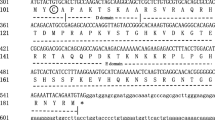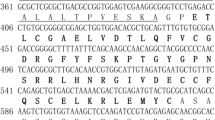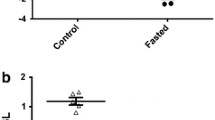Abstract
In this study, the GH and IGF-I of the Russian sturgeon (rs), Acipenser gueldenstaedtii, were cloned and sequenced, and their mRNA gene expression determined. In addition, to improve our understanding of the GH function, the expression of this hormone was assessed in young males and females. Moreover, IGF-I expression was quantified in young males and compared to that in older ones. The nucleotide sequence of the rsGH cDNA was 980 bp long and had an open reading frame of 642 bp, beginning with the first ATG codon at position 39 and ending with the stop codon at position 683. A putative polyadenylation signal, AATAAA, was recognized 42 bp upstream of the poly (A) tail. The position of the signal-peptide cleavage site was predicted to be at position 111, yielding a signal peptide of 24 amino-acids (aa) and a mature peptide of 190 aa. When the rsGH aa sequence was compared with other species, the highest degree of identity was found to be with mammalians (66–70% identity), followed by anguilliformes and amphibia (61%) and other fish (39–47%). The level of rsGH mRNA was discovered to be similar in pituitaries of females and males of 5 age groups (1, 2, 3,4, and 5-yr-old). In females and males, the levels did not change dramatically during the first 5 yr of growth. The partial nucleotide sequence of the rsIGF-I was 445 bp long and had an open reading frame of 396 bp, beginning with the ATG codon at position 50. The position of the signal-peptide cleavage site was predicted to be at position 187, yielding a signal peptide of 44 aa. The highest level of IGF-I mRNA expression was recorded in the kidney of adult sturgeons. The IGF-I mRNA expression levels in the intestine, pituitary gland, and liver were not significantly different. Low levels of expression were found in the brain, heart, and muscle. In most tissues, there was no significant difference between mRNA levels of one and 5-yr-old fish. In conclusion, based on the GH-sequence analysis, A. gueldenstaedtii is genetically distant from other teleosts. The expression of the GH mRNA was similar in males and females, and its level remained constant during the first 5 yr of growth. While the IGF-I mRNA expression differed amongst various tissues, the level in each tissue was similar in 1 and 5-yr-old fish.
Similar content being viewed by others
References
Perez-Sanchez J. The involvement of growth hormone in growth regulation, energy homeostasis and immune function in the gilthead sea bream (Sparus aurata): A short review. Fish Physiol Biochem 2000, 22: 135–44.
Moriyama S, Ayson FG, Kawauchi H. Growth regulation by insulin-like growth factor-I in fish. Biosci Biotechnol Biochem 2000, 64: 1553–62.
Niall HD, Hogan ML, Sauer R, Rosenblum IY, Greenwood FC. Sequences of pituitary and placental lactogenic and growth hormones: evolution from a primordial peptide by gene reduplication. Proc Natl Acad Sci U S A 1971, 68: 866–70.
Chao SC, Pan FM, Chang WC. Purification of carp growth hormone and cloning of the complementary DNA. Biochim Biophys Acta 1989, 1007: 233–6.
Funkenstein B, Chen TT, Powers DA, Cavari B. Cloning and sequencing of the gilthead seabream (Sparus aurata) growth hormone-encoding cDNA. Gene 1991, 103: 243–7.
Mahmoud SS, Moloney MM, Habibi HR. Cloning and sequencing of the goldfish growth hormone cDNA. Gen Comp Endocrinol 1996, 101: 139–44.
Nicoll CS, Steiny SS, King DS, et al. The primary structure of coho salmon growth hormone and its cDNA. Gen Comp Endocrinol 1987, 68: 387–99.
Rentier-Delrue F, Swennen D, Philippart JC, et al. Tilapia growth hormone: molecular cloning of cDNA and expression in Escherichia coli. DNA 1989, 8: 271–8.
Saito A, Sekine S, Komatsu Y, Sato M, Hirano T, Itoh S. Molecular cloning of eel growth hormone cDNA and its expression in Escherichia coli. Gene 1988, 73: 545–51.
Tanaka M, Toma Y, Ohkubo T, Sudo S, Nakashima K. Sequence of the flounder (Paralichthys olivaceus) growth hormone-encoding gene and its promoter region. Gene 1995, 165: 321–2.
Yasuda A, Yamaguchi K, Noso T, et al. The complete amino acid sequence of growth hormone from sturgeon (Acipencer guldenstadti). Biochim Biophys Acta 1992, 1120: 297–304.
Inoue K, Iwatani H, Takei Y. Growth hormone and insulin-like growth factor I of a Euryhaline fish Cottus kazika: cDNA cloning and expression after seawater acclimation. Gen Comp Endocrinol 2003, 131: 77–84.
Hurvitz A, Degani G, Goldberg D, Din SY, Jackson K, Levavi-Sivan B. Cloning of FSHbeta, LHbeta, and glycoprotein alpha subunits from the Russian sturgeon (Acipenser gueldenstaedtii), beta-subunit mRNA expression, gonad development, and steroid levels in immature fish. Gen Comp Endocrinol 2005, 140: 61–73.
Bonfield JK, Smith K, Staden R. A new DNA sequence assembly program. Nucleic Acids Res 1995, 23: 4992–9.
Nielsen H, Engelbrecht J, Brunak S, von Heijne G. Identification of prokaryotic and eukaryotic signal peptides and prediction of their cleavage sites. Protein Eng 1997, 10: 1–6.
Higgins DG, Sharp PM. Fast and sensitive multiple sequence alignments on a microcomputer. Comput Appl Biosci 1989, 5: 151–3.
Livak KJ, Schmittgen TD. Analysis of relative gene expression data using real-time quantitative PCR and the 2(-Delta Delta C(T)) Method. Methods 2001, 25: 402–8.
Muller PY, Janovjak H, Miserez AR, Dobbie Z. Processing of gene expression data generated by quantitative realtime RT-PCR. Biotechniques 2002, 32: 1372–9.
Rozen S, Skaletsky HJ. Primer3 on the WWW for general users and for biologist programmers. In: Krawetz S, Misener S eds. Bioinformatics Methods and Protocols: Methods in Molecular Biology. Totowa, NJ: Humana Press. 2000, 365–86.
Goldberg D, Jackson K, Yom-Din S, Degani G. Growth Hormone of Trichogaster trichopterus: cDNA Cloning, Sequencing and Analysis of mRNA Expression during Oogenesis. J Aqua Trop 2004, 19: 215–29.
Degani G, Jackson K, Yom-Din S, Goldberg D. cDNA cloning and mRNA expression of growth hormone in Belontiidae (Anabantoidei suborder) fish. Israel J Aquaculture 2006, 58: 124–36.
Law MS, Cheng KW, Fung TK, Chan YH, Yu KL, Chan KM. Isolation and characterization of two distinct growth hormone cDNAs from the goldfish, Carassius auratus. Arch Biochem Biophys 1996, 330: 19–23.
Chang YS, Liu CS, Huang FL, Lo TB. The primary structures of growth hormones of three cyprinid species: bighead carp, silver carp, and grass carp. Gen Comp Endocrinol 1992, 87: 385–93.
Vestling M, Murphy C, Fenselau C, Chen TT. Disulfide bonds in native and recombinant fish growth hormones. Mol Mar Biol Biotechnol 1991, 1: 73–7.
Lewis UJ, Singh RN, Tutwiler GF, Sigel MB, VanderLaan EF, VanderLaan WP. Human growth hormone: a complex of proteins. Recent Prog Horm Res 1980, 36: 477–508.
Guan JL, Machamer CE, Rose JK. Glycosylation allows cell-surface transport of an anchored secretory protein. Cell 1985, 42: 489–96.
Fontana F. Chromosomal nucleolar organizer regions in four sturgeon species as markers of karyotype evolution in Acipenseriformes (Pisces). Genome 1994, 37: 888–92.
Lorens J, Nerland AH, Male R, Lossius I, Telle W, Totland G. The nucleotide sequence of Atlantic salmon growth hormone cDNA. Nucleic Acids Res 1989, 17: 2352.
Ayson FG, de Jesus EG, Amemiya Y, Moriyama S, Hirano T, Kawauchi H. Isolation, cDNA cloning, and growth promoting activity of rabbitfish (Siganus guttatus) growth hormone. Gen Comp Endocrinol 2000, 117: 251–9.
Duguay SJ, Swanson P, Dickhoff WW. Differential expression and hormonal regulation of alternatively spliced IGF-I mRNA transcripts in salmon. J Mol Endocrinol 1994, 12: 25–37.
Shamblott MJ, Chen TT. Identification of a second insulin-like growth factor in a fish species 1992. Proc Natl Acad Sci U SA 1992, 89: 8913–7.
Liang YH, Cheng CH, Chan KM. Insulin-like growth factor IEa2 is the predominantly expressed form of IGF in common carp (Cyprinus carpio). Mol Mar Biol Biotechnol 1996, 5: 145–52.
McRory JE, Sherwood NM. Catfish express two forms of insulin-like growth factor-I (IGF-I) in the brain. Ubiquitous IGF-I and brain-specific IGF-I. J Biol Chem 1994, 269: 18588–92.
Nagamatsu S, Chan SJ, Falkmer S, Steiner DF. Evolution of the insulin gene superfamily. Sequence of a preproinsulin-like growth factor cDNA from the Atlantic hagfish. J Biol Chem 1991, 266: 2397–402.
Chen JY, Tsai HL, Chang CY, Wang JI, Shen SC, Wu JL. Isolation and characterization of tilapia (Oreochromis mossambicus) insulin-like growth factors gene and proximal promoter region. DNA Cell Biol 1998, 17: 359–76.
Duan C, Plisetskaya EM. Nutritional regulation of insulin-like growth factor-I mRNA expression in salmon tissues. J Endocrinol 1993, 139: 243–52.
Gabillard JC, Weil C, Rescan PY, Navarro I, Gutierrez J, Le Bail PY. Effects of environmental temperature on IGF-1, IGF2, and IGF type I receptor expression in rainbow trout (Oncorhynchus mykiss). Gen Comp Endocrinol 2003, 133: 233–42.
Shamblott MJ, Cheng CM, Bolt D, Chen TT. Appearance of insulin-like growth factor mRNA in the liver and pyloric ceca of a teleost in response to exogenous growth hormone. Proc Natl Acad Sci USA 1995, 92: 6943–6.
Author information
Authors and Affiliations
Corresponding author
Rights and permissions
About this article
Cite this article
Din, S.Y., Hurvitz, A., Goldberg, D. et al. Cloning of Russian sturgeon (Acipenser gueldenstaedtii) growth hormone and insulin-like growth factor I and their expression in male and female fish during the first period of growth. J Endocrinol Invest 31, 201–210 (2008). https://doi.org/10.1007/BF03345591
Accepted:
Published:
Issue Date:
DOI: https://doi.org/10.1007/BF03345591




